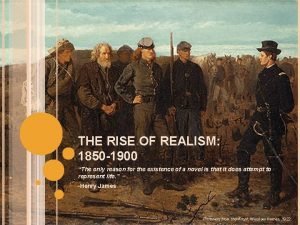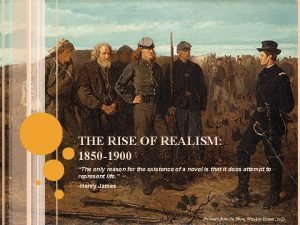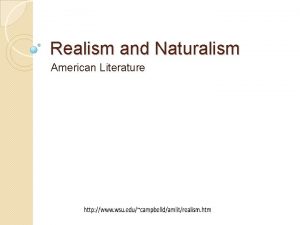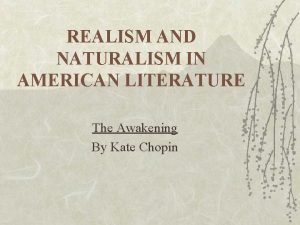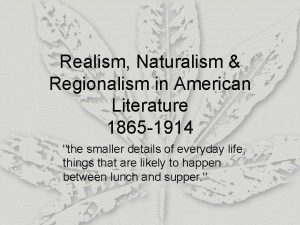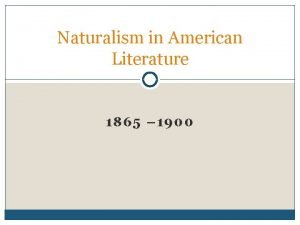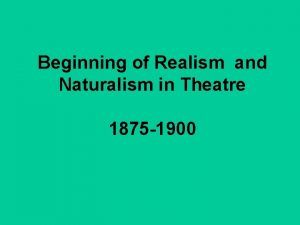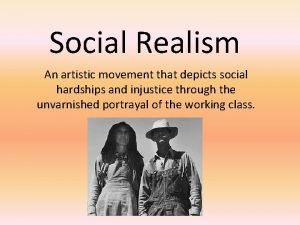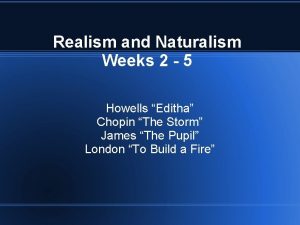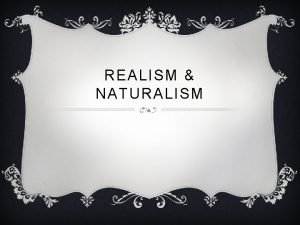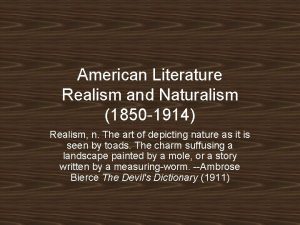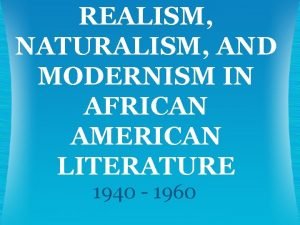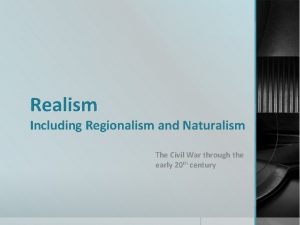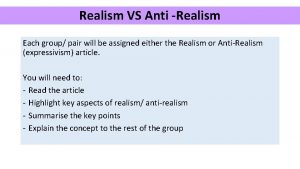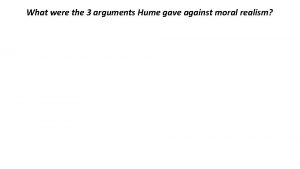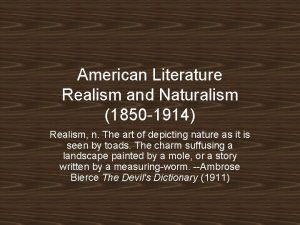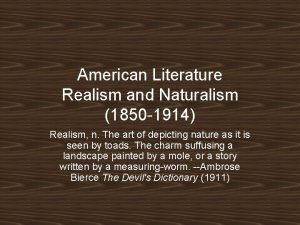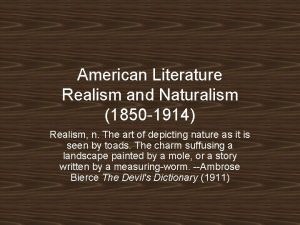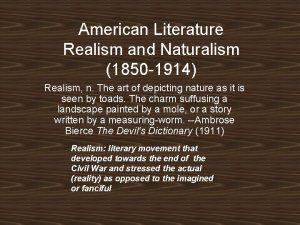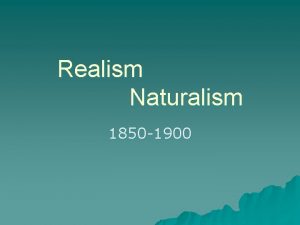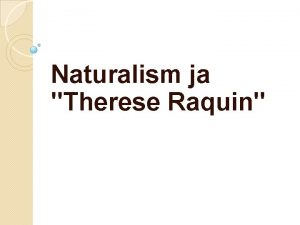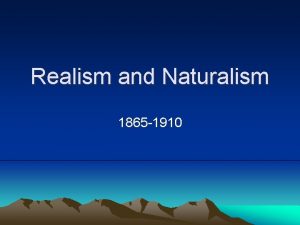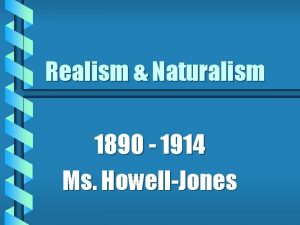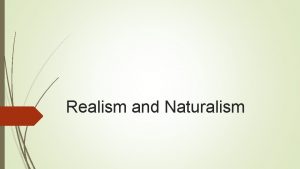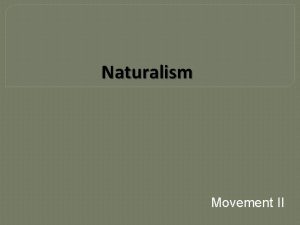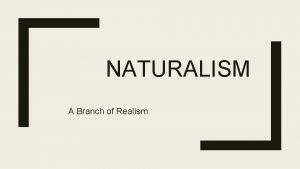Realism Naturalism 1850 1914 Realism The Faithful representation
















- Slides: 16

Realism & Naturalism { (1850 -1914) Realism – “The Faithful representation of reality” “Verisimilitude”

The writing of this period steered away from the Romantic, highly imaginative fiction from the early 1800’s. The four main movements are known as: - Realism - Naturalism - “Literature of Discontent” - Regionalism LITERARY MOVEMENTS

What is Verisimilitude? The appearance of being true or real It is a literary movement that developed towards the end of the Civil War and stressed the actual (reality) as opposed to the imagined or fanciful. Realism was a reaction against romanticism .

Romance Realism Aspired to the ideal Thought to be more democratic Thought to be more gentle since it Critics stressed the potential for did not show the vulgar details of life vulgarity and its emphasis on the commonplace. Ending is often happy Ending is often unhappy Writer is interested in history or legend (Examples: Irving and Poe) Writer is interested in recent or contemporary life.

Renders reality closely and in comprehensive detail. Character is more important than action and plot; complex ethical choices are often the subject. Characters appear in their real complexity of temperament and motive; they are in explicable relation to nature, to each other, to their social class, to their own past. Events will usually be plausible. Realistic novels avoid the sensational, dramatic elements of romanticism Class is important; the novel has traditionally served the interests and aspirations of an insurgent middle class Objective writing about ordinary characters in ordinary situations: “Real Life” Characteristics of Realism

Edward Hopper’s Painting

Naturalism Literary movement that was an extension of Realism Depicted real people in real situations like realism, but believed that forces larger than the individual – nature, fate, heredity – shaped individual destiny. Their writing was inspired by hardships, whether it was war, the frontier, or urbanization. Naturalism – Characteristics Characters: usually ill-educated or lower class; lives governed by the forces of heredity, instinct, passion, or the environment; the criminal, the fallen, the downand-out. Example: Mark Twain’s “Huckleberry Finn” Themes of survival (man against nature, man against himself), determinism (nature as an indifferent force on the lives of human beings), and violence



Along the lines of naturalism, the social problems of this period were seen as a force to deal with. Many groups, from women to freed slaves, started expressing their discontent with the way things were. They started addressing these issues in their writing. Literature of Discontent



Regionalism is all about “local flavor” or “local color. ” “Local Color” means a reliance on minor details and dialects. They usually wrote about the South or the West. More often than not, these stories were full of humor and small-town characters. Regionalism

The Local Color Movement (1865 -1880) Americans wanted to know what their country looked like, and how the varied races which made up their growing population lived and talked. Western regionalists wrote about men and women who dressed differently, spoke differently, and had different social ways. (Fantastic deserts, mile deep canyons, mountains, villages where the only woman was the town whole, camps where they only currency was gold-dust) South regionalists told of swamps where the cypress grew out of the green- scummed water, and of the cities where the obsessive bloodconsciousness of its inhabitants testified to the mingling of the races. Mid Western authors narrated tales of the plains where a man could be lost or ruined by hailstorm; of cities where fortunes were made or lost in a day’s trading on the beef or grain exchanges.

The Homestead and Building of the Barbed Wire Fence - Benton

 Realism 1850 to 1900
Realism 1850 to 1900 Realist novel
Realist novel Characteristic of realism
Characteristic of realism Realism and naturalism in american literature
Realism and naturalism in american literature The awakening realism
The awakening realism Realism v naturalism
Realism v naturalism Characteristics of naturalism
Characteristics of naturalism Naturalist playwrights
Naturalist playwrights Realism vs naturalism in art
Realism vs naturalism in art Is editha realism or naturalism
Is editha realism or naturalism Realism vs naturalism in literature
Realism vs naturalism in literature Romanticism vs realism vs naturalism
Romanticism vs realism vs naturalism Naturalism vs modernism
Naturalism vs modernism Realism regionalism and naturalism
Realism regionalism and naturalism Realism vs anti realism
Realism vs anti realism Briefly recap
Briefly recap Realism vs anti realism
Realism vs anti realism
